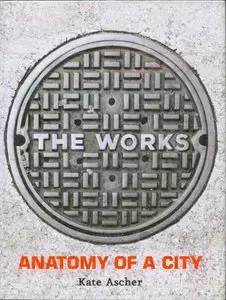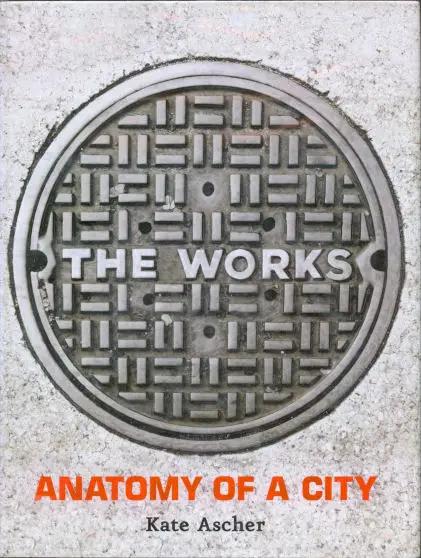Kate Ascher, "The Works: Anatomy of a City"
Penguin Press | 2005 | ISBN: 1594200718 | siPDF | 240 pages | 22.8 MB
Penguin Press | 2005 | ISBN: 1594200718 | siPDF | 240 pages | 22.8 MB
Have you ever wondered how the water in your faucet gets there? Where your garbage goes? What all the pipes underneath city streets do? For those who have ever stopped mid-crosswalk, looked around at a rapidly moving metropolis, and asked themselves "How does it all work?," The Works is required reading.
Amazon.com Review
Kate Ascher could not have chosen a much drier topic for a book than water mains, parking meters, railroad classification yards, and the other doodads of city infrastructure. But in Ascher's captivating book, The Works, the innards of New York City come alive. Wonderfully illustrated, the book combines text, maps, and other graphics to tell the story of the systems that keep America's greatest city running smoothly. How are traffic lights coordinated? How do potholes form and which areas have streets with the best "smoothness score"? How is mail processed? What happens when you flush the toilet? Ascher, who has a PhD in government from the London School of Economics and is now executive vice president of the New York City Economic Development Corporation, dissects the colorful workings of all these systems and much more.
The Works contains a section on pretty much every aspect of the Big Apple's infrastructure. You'll learn the mystery of the shiny silver tanks that have become a familiar sight on New York streets. (They prevent moisture from damaging underground phone lines.) Ascher explains how the city's 23 million daily pieces of mail are processed. We also learn about the 27-mile underground pneumatic mail tube that used to carry canisters with 500 letters up to 30 miles per hour around Manhattan. Also interesting: the story of the nine-foot-long, 800-pound robot submarine that city engineers send to probe leaks in the Delaware Aqueduct—which, it might interest you to know, is the world's longest continuous underground tunnel. And you'll find out all about Colonel Waring and his "White Wings." A great coffee table book for New York lovers or anyone with a curiosity bone.
Product Description
How much do you really know about the systems that keep a city alive? The Works: Anatomy of a City contains everything you ever wanted to know about what makes New York City run. When you flick on your light switch the light goes on—how? When you put out your garbage, where does it go? When you flush your toilet, what happens to the waste? How does water get from a reservoir in the mountains to your city faucet? How do flowers get to your corner store from Holland, or bananas get there from Ecuador? Who is operating the traffic lights all over the city? And what in the world is that steam coming out from underneath the potholes on the street? Across the city lies a series of extraordinarily complex and interconnected systems. Often invisible, and wholly taken for granted, these are the systems that make urban life possible.
The Works: Anatomy of a City offers a cross section of this hidden infrastructure, using beautiful, innovative graphic images combined with short, clear text explanations to answer all the questions about the way things work in a modern city. It describes the technologies that keep the city functioning, as well as the people who support them—the pilots that bring the ships in over the Narrows sandbar, the sandhogs who are currently digging the third water tunnel under Manhattan, the television engineer who scales the Empire State Building's antenna for routine maintenance, the electrical wizards who maintain the century-old system that delivers power to subways.
Did you know that the Verrazano-Narrows Bridge is so long, and its towers are so high, that the builders had to take the curvature of the earth's surface into account when designing it? Did you know that the George Washington Bridge takes in approximately $1 million per day in tolls? Did you know that retired subway cars travel by barge to the mid-Atlantic, where they are dumped overboard to form natural reefs for fish? Or that if the telecom cables under New York were strung end to end, they would reach from the earth to the sun? While the book uses New York as its example, it has relevance well beyond that city's boundaries as the systems that make New York a functioning metropolis are similar to those that keep the bright lights burning in big cities everywhere.
The Works is for anyone who has ever stopped midcrosswalk, looked at the rapidly moving metropolis around them, and wondered, how does this all work?
Contents
A Note To ReadersTags: NewYorkCity, Infrastructure, CityPlanning, History
Moving People
Streets
Subway
Bridges & Tunnels
Moving Freight
Rail Freight
Maritime Freight
Air Cargo
Markets
Power
Electricity
Natural Gas
Steam
Communications
Telephone
Moving the Mail
The Airwaves
Keeping It Clean
Water
Sewage
Garbage
The Future
Moving People
Moving Freight
Power
Communications
Keeping It Clean
Acknowledgments
Contributing Artists
Image Credits
Index
Christopher Cooper & Rober...ure of Homeland Security"
Jasper Becker, "Dragon Ri...side Look At China Today"
Thomas L. Friedman, "Hot,...How It Can Renew America"
Daniel Yergin, "The Prize... Oil, Money, & Power"
Matthew Stein, "When Tech...& Planetary Survival"
Thomas L. Friedman, "The ...the Twenty-first Century"



